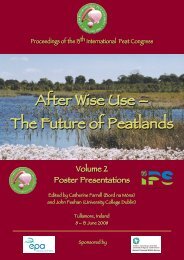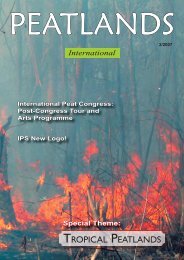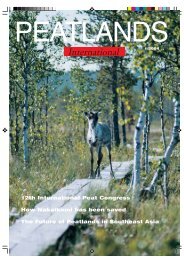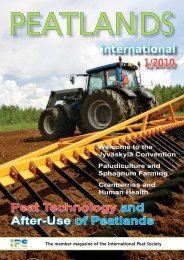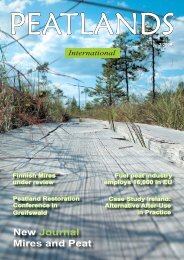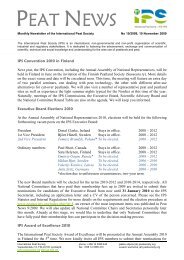peatlands 1 taitto.indd - International Peat Society
peatlands 1 taitto.indd - International Peat Society
peatlands 1 taitto.indd - International Peat Society
Create successful ePaper yourself
Turn your PDF publications into a flip-book with our unique Google optimized e-Paper software.
Recording the Past: the Power of <strong>Peat</strong><br />
<strong>Peat</strong> bogs are powerful archives<br />
containing records on<br />
the environment and culture<br />
of the past, such as climate<br />
change - as indicated by<br />
botanical remains - and bog<br />
finds such as archaeological<br />
materials, including human<br />
remains (bog bodies). Some<br />
recent research highlights<br />
from the Netherlands are<br />
presented.<br />
<strong>Peat</strong> bogs are growing continuously<br />
under certain climatic conditions such<br />
as those that prevailed during the<br />
Holocene - the present geological period<br />
that, following the last ice age, has<br />
lasted for approximately 11,500 years.<br />
<strong>Peat</strong> bogs and palaeoclimate<br />
By digging into terrestrial deposits, one<br />
travels, in general, back in time from<br />
the present to the past - the deeper,<br />
the older. The relative occurrence of<br />
plant species at a certain depth (and<br />
thus at a certain time in the past)<br />
indicates climatic conditions, like tem-<br />
Figure 2: The variations in the natural 14 C content, as measured in tree<br />
rings dated by dendro-chronology. The 14 C content is plotted as the<br />
deviation from the normal level, and is corrected for radioactive decay.<br />
46 PEATLANDS <strong>International</strong> 1/2006<br />
perature and humidity, under which the<br />
plants at this depth were growing. In<br />
general terms, dominance of tree pollen<br />
is indicative of warmth; the relative<br />
abundance of different species gives<br />
fi ner detail. For example, there usually<br />
is a dominance of birch and pine during<br />
the initial phase of an interglacial<br />
like the Holocene, followed later by<br />
mixed forest (oak, elm, hazel) in the<br />
temperate regions. Thus, records of<br />
preserved botanical remains like pollen<br />
and macrofossils (branches, leaves)<br />
form a proxy for the palaeoclimate.<br />
<strong>Peat</strong> bogs consist of bog mosses<br />
(species of Sphagnum). They are<br />
rain-fed and grow continuously. After<br />
death, the mosses are well preserved.<br />
Continual growth of the peat bog surface<br />
and burial of dead organic matter<br />
leads to peat sequences that can exceed<br />
10 m in depth.<br />
Radiocarbon Dating<br />
The chronology of such deposits can<br />
be obtained by 14 C (or Radiocarbon)<br />
dating of organic remains like peat,<br />
macrofossils, or pollen. Radiocarbon is<br />
a natural radioactive<br />
isotope<br />
(with a half-life<br />
of 5730 years)<br />
of the element<br />
Carbon.<br />
This isotope is<br />
continuously<br />
produced by<br />
cosmic radiation<br />
in the<br />
upper atmosphere,<br />
and is<br />
taken up by<br />
the plants by<br />
photosynthesis.<br />
From there<br />
it fi nds its way<br />
into all living<br />
organisms via<br />
the food chain.<br />
There is an<br />
equilibrium<br />
Text and photos: J. van der Plicht<br />
J. van der Plicht.<br />
between uptake and decay of 14 C . After<br />
death of the organism, there is no<br />
longer uptake of 14 C; radioactive decay<br />
causes the content of 14 C to decrease.<br />
Hence, by measuring the remaining<br />
14 C content of for example the botanical<br />
remains from within a peat bog, the<br />
age of these remains (more precisely:<br />
the moment of death) can be established.<br />
The isotope 14 C provides in fact<br />
a clock, built into the organic residues.<br />
Although this sounds like a simple<br />
and straightforward principle, in practice<br />
there are many complications of<br />
which only one is mentioned here. For<br />
the simple dating model to work, one<br />
has to assume that the natural atmospheric<br />
14 C concentration is constant<br />
throughout time. It appears that this<br />
is not the case: the cosmic ray fl ux impinging<br />
on earth, and thus the amount<br />
of 14 C produced in the atmosphere,<br />
depends on factors like the strength<br />
of the earth’s magnetic fi eld, and solar<br />
activity.<br />
In addition, the 14 C concentrations<br />
are extremely small (1:1012-1015) so<br />
that measuring them requires highlyspecialized<br />
equipment, such as shown<br />
in Figure 1.



